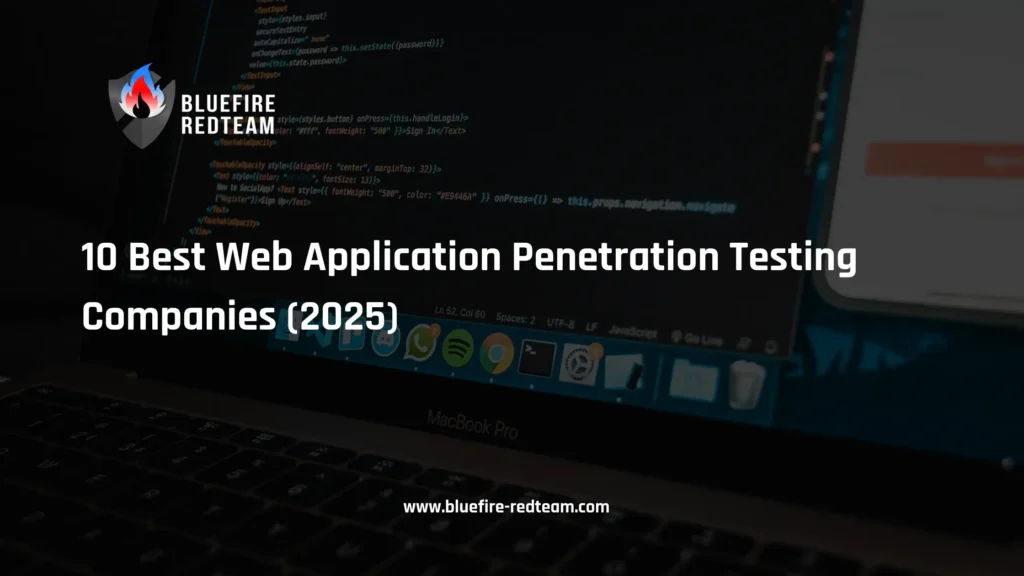Web applications are among the most targeted assets for hackers, as evidenced by the 67% increase in cyberattacks on them over the previous year. A single unpatched vulnerability can result in data breaches, noncompliance with regulations, and millions of dollars in losses for companies in the financial, healthcare, software as a service, and e-commerce sectors.
This is where web application penetration testing comes in — a proactive, controlled security assessment designed to identify and exploit vulnerabilities before malicious actors can.
The challenge? Not all pentesting providers are equal.
The right company will not only find flaws but also provide clear remediation steps, compliance guidance, and ongoing support.
In this guide, we’ll cover:
- What web application penetration testing is
- Why it’s important for your business
- 10 of the best web app pentesting companies in 2025
- How to choose the right partner
Quick Pick: Bluefire Redteam — the go-to choice for enterprises and regulated industries that need expert web application security testing.
Bluefire Redteam’s Global Customer Testimonials for Penetration Testing
Get Your Pen Test Quote Now
What is Web Application Penetration Testing?
Security experts use web application penetration testing, which simulates a cyberattack on a web application, to find, exploit, and record security flaws.
Web application penetration testing provides a far more accurate view of your security posture than automated vulnerability scans because it simulates real-world attack scenarios using manual techniques.
The primary objectives are:
- Identify vulnerabilities such as SQL injection, XSS (Cross-Site Scripting), CSRF (Cross-Site Request Forgery), and authentication bypasses.
- Assess business logic flaws that automated scanners often miss.
- Test your application against the OWASP Top 10 risks.
- Validate the effectiveness of existing security controls.
- Provide remediation guidance to close identified gaps.
Why it matters:
- Prevents breaches by finding vulnerabilities before attackers do.
- Supports compliance with frameworks like PCI DSS, HIPAA, and SOC 2.
- Protects brand reputation by reducing the risk of data exposure.
Quick comparison table of top web application penetration testing providers
| Company | Specialty / Focus | Certifications | Ideal For |
|---|---|---|---|
| Bluefire Redteam | Enterprise & Regulated Industries, Red Teaming, Offensive Security Assessments | OSCP, CREST, CISSP, GPEN, GWAPT, OSCE | Finance, Healthcare, Gov, SaaS, SMEs and Large Enterprise penetration testing |
| Offensive Security | Security Training & Testing | OSCP, OSCE | Large orgs w/ in-house security |
| Bishop Fox | Comprehensive Security Services | OSCP, OSCE, GWAPT | Enterprise-level pentesting |
| Trustwave | Managed Security Services | CISSP, CISM | Compliance-focused orgs |
| Cobalt.io | Pentest as a Service (PTaaS) | OSCP, CEH | SMBs & startups |
| Rapid7 | Security Platform + Services | OSCP, CEH | Businesses using Insight platform |
| NetSPI | Full-Scope Offensive Security | OSCP, OSCE, GPEN | Large enterprises |
| Secureworks | Threat Intelligence & Testing | CISSP, CISM | Compliance + intel needs |
| Intruder | Automated & Manual Testing | CREST, OSCP | SMBs needing ongoing scans |
| Core Security | Vulnerability Mgmt + Testing | CISSP, CEH | Mid-market companies |
1. Bluefire Redteam – Quick #1 Pick by global companies
Best for: Enterprises, and high-security sectors (finance, healthcare, SaaS, government).
Web application penetration testing is the primary service, not a secondary add-on, that Bluefire Redteam specialises in. To find vulnerabilities that automated scans miss, their team combines manual exploitation with sophisticated tools.
Highlights:
- Certified experts (OSCP, CREST, CISSP)
- OWASP Top 10 & NIST-aligned methodology
- Developer-friendly reports with clear remediation steps
- Retesting included to verify fixes
- Compliance expertise for HIPAA, PCI DSS, and SOC 2
Case Study:
Helped a SaaS platform reduce exploitable vulnerabilities by 92% within 30 days, closing gaps that could have led to credential theft.

2–10. Other Leading Providers
- Offensive Security — Known for OSCP training & advanced pentesting.
- Bishop Fox — Elite team for large-scale, complex environments.
- Trustwave — Strong for compliance-heavy industries.
- Cobalt.io — PTaaS model for faster engagements.
- Rapid7 — Integrated with their Insight security platform.
- NetSPI — Enterprise-level offensive security programs.
- Secureworks — Pentesting plus advanced threat intelligence.
- Intruder — Ongoing vulnerability scanning with manual validation.
- Core Security — Blends vulnerability management with pentesting services.
When Should You Perform Web Application Penetration Testing?
- Before launching a new app or major feature
- After significant code changes
- At least annually to meet compliance standards
- Following a security incident
Buyer’s Guide: Choosing the Right Web Application Penetration Testing Partner
When selecting a provider for web application penetration testing:
- Industry Experience — Have they worked with your type of application?
- Manual + Automated Approach — Manual testing is essential for thorough coverage.
- Certifications — OSCP, CREST, GPEN indicate high skill.
- Reporting Quality — Reports should be clear for both executives and developers.
- Post-Test Support — Vulnerabilities should be re-tested after fixes.
Next Steps
If your web application handles sensitive data, payments, or critical business logic, it’s not a question of if attackers will try to exploit it, but when.
Schedule Your Web Application Security Assessment →
FAQ – Web Application Penetration Testing
- What is web application penetration testing?Web application penetration testing is a simulated cyberattack on a web app to find and exploit vulnerabilities before real attackers do. It identifies flaws like SQL injection, XSS, CSRF, authentication bypass, and logic errors.
- Why is web application penetration testing important?
It helps prevent data breaches, ensures compliance with standards like PCI DSS, HIPAA, and SOC 2, and protects brand reputation by proactively addressing security weaknesses.
- How often should I perform web application penetration testing?
At least once per year, and after any major code changes, new feature releases, or security incidents.
- How long does a web application penetration test take?A typical assessment lasts 5–15 business days, depending on application complexity, number of user roles, and testing depth.
- How much does web application penetration testing cost?Prices range from $5,000 to $50,000+ based on scope, size, and industry compliance requirements.
- Does penetration testing disrupt normal operations?No — ethical testers follow safe procedures that won’t damage systems or interrupt regular business activities.
- What’s the difference between web application penetration testing and vulnerability scanning?Vulnerability scanning is automated and finds known weaknesses, while penetration testing uses manual techniques to exploit vulnerabilities, uncover logic flaws, and validate real-world risk.
- Who should conduct my web application penetration testing?Choose certified professionals (OSCP, CREST, GPEN) with proven industry experience and a track record of thorough reporting and remediation support.
- How much does web application penetration testing cost?Pricing usually ranges from $2,000 to $20,000+ depending on the number of applications, complexity, compliance requirements, and whether manual testing is included.


